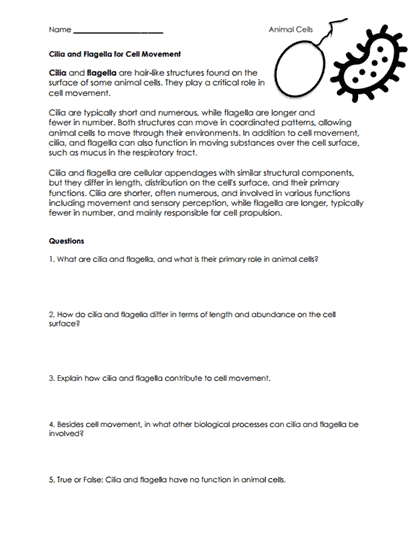Cilia and Flagella for Cell Movement

Worksheet Description
This worksheet delves into the study of cilia and flagella, two hair-like structures present on the surface of some animal cells. These organelles play pivotal roles in enabling cell movement, with cilia typically being shorter and more numerous and flagella being longer with fewer in number. Both structures facilitate the cell’s navigation through its environment and assist in moving substances over the cell surface. The provided illustration offers a visual representation of an animal cell showcasing these structures, aiding in conceptual clarity.
To effectively engage with this worksheet, students should commence by thoroughly reading the introductory text, ensuring comprehension of the fundamental differences and similarities between cilia and flagella. The accompanying diagram serves as a helpful visual guide, assisting students in conceptualizing the appearance and arrangement of these structures on an animal cell. After grasping the foundational concepts, students can transition to answering the listed questions, referencing the primary content as needed for accurate responses. Concluding the exercise with a review of answers, juxtaposed against the main content, is recommended for consolidation of understanding.
This worksheet aspires to familiarize students with the biological intricacies of cilia and flagella within animal cells. By delineating the structural differences, functions, and distribution of these cellular appendages, the material fosters an in-depth understanding of their roles in cell movement and surface transportation. The comparative approach adopted in the worksheet, contrasting cilia with flagella, encourages analytical thinking and a nuanced appreciation of cellular structures. Through descriptive content and probing questions, students are propelled towards a holistic understanding of these vital cellular components and their significance in cellular biology.
